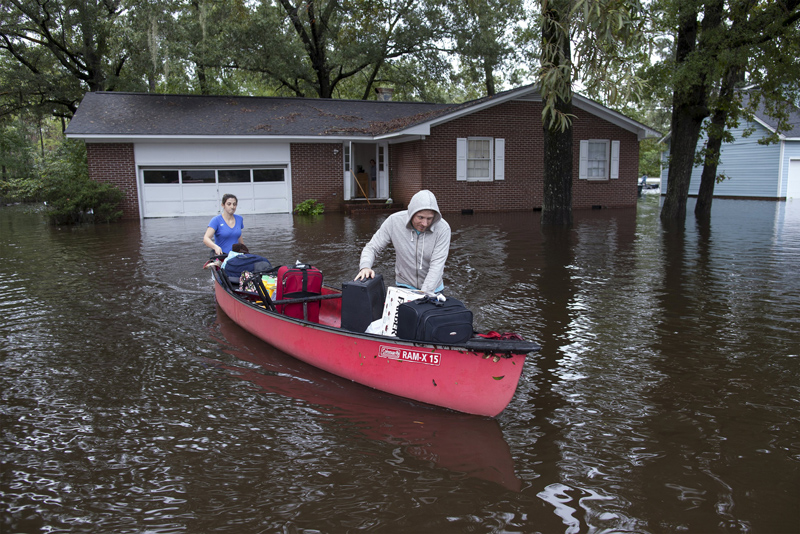
CHARLESTON—It was called the 1,000 year storm and brought extreme rains that deluged South Carolina over the past week resulting in catastrophic flooding in the Midlands and places around the Lowcountry.
The media reported that at least 15 people lost their lives and rescuers plucked hundreds from swamped cars and flooded houses. Even though the sun has returned, some areas of the state are still in danger from trickle down flooding causing rivers to rise. Those areas include: Georgetown County, Jamestown, and Givhans Ferry.
“We simply ask for prayers especially for the families of those who lost their lives in this horrific storm,” Bishop Robert E. Guglielmone told The Miscellany. “Many people lost homes, cars and other possessions, but in time and with assistance these can be replaced. The strong spirit of our people in South Carolina and their lively faith will get us through this difficult time and will sustain us.”

A State of Emergency was declared in South Carolina on Oct. 1 as unprecedented heavy rains and flash flood conditions raged throughout the state. Residents were asked to avoid unnecessary travel. Bishop Guglielmone had to cancel the “On Fire With Faith” conference set for Oct. 2-3 in Simpsonville. Life Chain demonstrations planned for that Sunday were also postponed and St. Andrew School in Myrtle Beach had to reschedule Taste of the Town, its major fundraising event, to Nov. 5.
The National Weather Service reported that from Oct. 1-5, Charleston saw 23.61 inches of rain; Summerville, which also had significant flooding and evacuations, had 19.47. Columbia Airport had 10.77 inches.
It was the dams in Columbia, however, that wrought more damage. The South Carolina Emergency Management Division reported that of 18 dams officials are closely monitoring in the Midlands, nine have breached or failed completely and one was intentionally breached to relieve pressure on it. The dams are part of the 70-mile network of lakes and streams that make up the Gills Creek Watershed.
The emergency management division also reported that several rivers were still above the flood stage. Mandatory evacuations were ordered for some areas and a curfew was mandated by city officials over the weekend. Motorists were told to stay home as some roads had collapsed.

Msgr. Richard Harris, diocesan vicar general, is pastor of St. Joseph Church located near one of the flooded areas by Lake Katherine. The church was without power and had to be closed on Sunday, so no Masses were held. Msgr. Harris said he knew of 10 parishioners, so far, who had to be rescued by boat. “They have lost everything,” he said. One family had to put their children on their shoulders and carry them through chin-deep water, he added.
Florence, Richland, Marlboro and Horry Counties could face possible evacuations over the next 48 hours, she said.

Tracy Bates, Catholic Mutual’s claims risk manager for the Diocese of Charleston, received a steady stream of damage reports from parishes. St. Mary Our Lady of Hope in Summerton was flooded with an estimated eight inches of water and was still submerged.
She said a couple of inches of water seeped into Blessed Sacrament School’s ground floor and the Carter-May Residence for assisted living also had water creep into its hallways. On the peninsula, she received reports that Sacred Heart Church suffered flooding that submerged its basement boiler room, which houses the electrical system. South Carolina Electric and Gas will have to make sure there is no electrical risk before any damage control can begin.
Other parishes that reported flooding and water damage include the lower chapel at the Cathedral of St. John the Baptist, Charleston Catholic, The Neighborhood House outreach center, St. Jude Church youth center building in Sumter, the library at St. Andrew in Myrtle Beach, St. John the Beloved in Summerville, and the rectory at St. Mary Our Lady of Ransom in Georgetown.
Bates said water mitigation teams have been called upon to dry out some of the structures as a first step.
“The longer the water sits, the worse the damage gets,” she said. “We also have to worry about mold.”
In addition to the bricks and mortar damage, the diocesan Office of Archives & Records Management was concerned about historically important items and put out a call to parishes to offer assistance with important documents.
“We’re happy to consult with vendors, help develop records recovery plans, find temporary housing for records, or make on-site visits,” said Brian Fahey, archivist.
Bishop Guglielmone has sent a request to pastors asking them to take up a special collection in the next few weeks to help parishioners who lost their homes and churches that sustained damage.
Any concerns about flooding, evacuations or road closures should be directed to the South Carolina Emergency Management Division, call 866-246-0133.
Top image: Residents use a canoe to evacuate a home surrounded by floodwaters in Conway, S.C., Oct. 5. (CNS photo/Randall Hill, Reuters)

